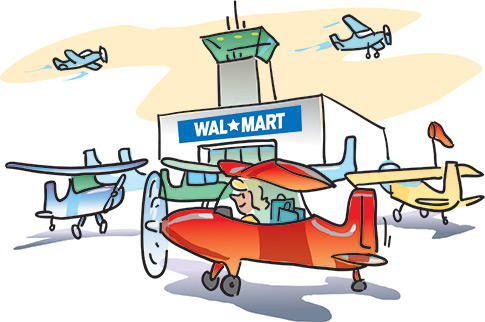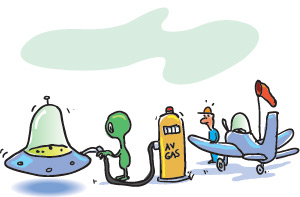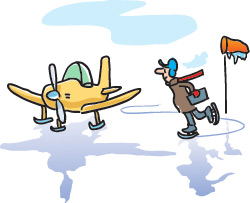The nation’s quirkiest airports
The top-seven list

Illustrations by John Holmes
Toss a casual question on the AOPA Forums, and you’ll come up with answers worth an article. The question was simple: “Which are the nation’s quirkiest airports?” On the advice of AOPA Pilot staff, I didn’t define the word quirky.
There were many different definitions of quirky. “Quirky-weird” won the top spot.
This was an unscientific survey. Following the posting, which brought 70 responses, the airports were ranked on a whim. They weren’t sent to PricewaterhouseCoopers, the company that tallies votes for the Oscars. Why seven? Because eight would have made the article too long.
1. LGM on the range
Greater Green River Intergalactic Spaceport, Wyoming (48U, alien identifier #%&@)
 There were numerous nominations for Green River’s welcome mat for aliens. There are deep ruts and tall grass the entire length of the runway, proof that little green men (LGM) are actually using it. “Maybe those deep ruts and tracks are from the heavy alien spacecraft,” said city Public Works Director Mike Nelson. Hmm, how does he know they are heavy? Debris, trash, and animal carcasses are often found on the runway. The key word is found, after the aliens have left. What more proof do you need?
There were numerous nominations for Green River’s welcome mat for aliens. There are deep ruts and tall grass the entire length of the runway, proof that little green men (LGM) are actually using it. “Maybe those deep ruts and tracks are from the heavy alien spacecraft,” said city Public Works Director Mike Nelson. Hmm, how does he know they are heavy? Debris, trash, and animal carcasses are often found on the runway. The key word is found, after the aliens have left. What more proof do you need?
There’s another explanation: City public works official Randy Koloff said hunters throw the remains of big game on the runway, including deer, elk, and antelope. Unless, of course, they are actually aliens and eat their kill raw right there—sort of a tailgate party for spaceships. The airport got its name because the city council “…did that as a joke,” Koloff said. That was a couple of decades ago. The town never marketed the joke, so there are no alien festivals or space burgers in town. “Several of our people could qualify as aliens,” said Nelson. “We’ve got some real weirdoes here.” He was offered a chance to be identified only as a city official for that last remark, but said he stands behind his statement.
Nelson said he gets at least three to five dozen calls a year from youngsters working on term papers about the airport. “It’s the coolest name for an airport.” There are plans to try to improve the runway, but until that happens, he suggests pilots not accustomed to rugged conditions land 20 miles away in Rock Springs, Wyoming.
There are steep drop-offs at both ends of the runway, a three-foot berm along its entire length, and you can’t see one end from the other. Obviously, it wasn’t built for human-flown airplanes. Oh, and you’ll need to watch for youngsters on recreational vehicles making cookie shapes in the dirt. City residents park their cars on the runway while they walk their dogs. It’s only graded in the spring before the mosquito spray airplanes arrive, and maybe twice after that in a year.
Spray-airplane pilots are very good at dodging cars, Nelson said.
2. A border runs through it
International Peace Garden Airport, Dunseith, North Dakota (S28)
Located exactly on the United States-Canada border, S28 is managed by the North Dakota Aeronautics Commission. Canadians land in North Dakota but taxi back to Canada to park. American pilots generally park in the United States. Both can meet up at the hamburger stand. Both United States and Canadian customs are available.
The International Peace Garden is half in Canada, and half in the United States, but the burger joint is on the American side. Canadians can descend the American steps and order a burger—as long as they go right back to Canada. The hamburger stand offers fries with gravy, something the Canadians appreciate.
There’s a big fly-in planned on Labor Day, so you can plan a trip and see how it works for yourself. Snow plowing is irregular in winter, and pilots need to call ahead for both the runway conditions and the hours of the Lunch Bar, as the restaurant is called.
3. Airplanes on ice
Alton Bay Ice Airport, New Hampshire (B18)
 This is a quirky airport because the runway doesn’t form until January and melts in spring. It is the only government-approved airport to be certified as a seaplane base in summer and an airport (iceport) in winter. It was the subject of a feature article (“ The Iceway Is Open,” January 2010 AOPA Pilot). There’s a video of the airport with the article on AOPA Online).
This is a quirky airport because the runway doesn’t form until January and melts in spring. It is the only government-approved airport to be certified as a seaplane base in summer and an airport (iceport) in winter. It was the subject of a feature article (“ The Iceway Is Open,” January 2010 AOPA Pilot). There’s a video of the airport with the article on AOPA Online).
The public airport is at the south end of Lake Winnipesaukee, which gets few airplanes in summer because of boat traffic and the lack of a good ramp. The ice airport operated for 30 years before the volunteer in charge could no longer meet a commitment to keep the runway plowed and free of snow.
The good news is that new volunteers were found, and the town of Alton Bay can enjoy winter tourist business once again.
4. IFR to a lake
Rangely Lake Seaplane Base, Rangely, Maine (M57)
Splash down with precision at Rangely Lake. It has RNAV, GPS, and NDB approaches to its water Runway 6/24. The lake is described as having intensive boating activity. Airport manager Steve Philbrick said it is not unusual for fishermen to be on the lake during IFR weather. Generally, seaplane operations stop sometime after November 1 because of colder weather and the chance of ice on the lake. Operations switch to a land airport nearby, which has nearly identical instrument approaches.
Philbrick estimated only a dozen aircraft a year make actual instrument approaches to the lake, including one commercial operator, a seaplane operator based at the lake, and the usual run of pilots wanting to refuel or conduct general aviation operations. Game wardens and search-and-rescue aircraft also use the approaches.
5. Welcome to Wal-Mart
Chehalis-Centralia Airport, Chehalis, Washington (CLS)
You’ll have to look at a photo to believe this. One of two runways was closed at Chehalis-Centralia airport and a Wal-Mart was placed in the middle of it. The photo of the airport on AOPA Online (you’ll find it under Flight Planning, AOPA Airports or search the site for KCLS) makes this abundantly clear.
Here’s what happened, as Allyn Roe tells it. This was all done before his time. In the late 1980s and early 1990s that runway was in disrepair and there was no money to fix it. “We could either use the money we didn’t have to repair it, or close it and develop it,” Roe said. With permission from the FAA, the controversial move was made.
Now, there’s a Wal-Mart, Home Depot, Starbucks, Walgreen’s, and an Applebee’s on the site. All of them pay lease fees to the airport for a total monthly income of $83,000. The airport is independent of local government.
One of our readers adds this comment. “And it was poetic justice in December 2007 when the nearby river overflowed its banks and flooded the Wal-Mart and the Home Depot.”Visit Chehalis-Centralia, where the Wal-Mart greeter says, “Cleared to land.”
6. Quirky, but friendly
Lowell Airport, Indiana (C97)
Lowell’s grass runway would have made the quirky category for its two instrument approaches alone, but this separate recognition is for the airport operator, Don Bailey. The report on the AOPA Forums was that a pilot landed there, got to meet Bailey and Bridget the dog, and left with apples and sweet corn. I called to ask, “Is that normal?”
“If the sweet corn is in, they all get some corn to take home,” said Bailey, 89. Visitors also get apples if they are in season, “even red raspberries,” and can buy gourmet popcorn Bailey grows, along with jelly his wife makes. Don’t forget about the honey; it’s from his beehives. “Last Saturday I had two airplanes fly in here just to buy popcorn,” he said.
He donates most of the popcorn to a missionary group to help them raise money. As a farmer, he raises corn, beans, and wheat on 300 acres in northwest Indiana. If you have ever circumnavigated Chicago you are familiar with the Peotone VOR, where one of his instrument approaches starts. Bailey is one mile from the state line.
7. Glass on grass
Georgia (7A9), Illinois (2K0), Ohio (2D7)
Lowell, Indiana, isn’t the only grass runway with an instrument approach. Chatter on the AOPA Forums for this article turned up four, with promises that more are out there. Beach City, Ohio (2D7) has VOR and GPS approaches. Airport manager Gary Slutz said there is probably one instrument approach a month to the Beach City runway.
It is well lit and easy to pick out among the surrounding farm fields. There’s no equipment to maintain, although Slutz has to monitor the construction of cell phone and other towers in the area.
Piatt County Airport in Monticello, Illinois, also has a VOR and GPS approach, while Peterson Field in Plains, Georgia, has DME, VOR, and GPS approaches to its 3,255-foot turf runway. The neat thing about grass runways is the width. This one is 230 feet wide.
It is managed by Tom Peterson, a test pilot for Beech Aircraft in the 1960s. His history, and that of the instrument approaches, is linked to former President Jimmy Carter who lives nearby.
“The Secret Service didn’t think President Carter ought to be using aural approaches,” Peterson said. An aural approach, he explained, is one where a small aircraft flies overhead while someone stands outside the airport office and listens for the engine. That worked well for the Cessna 310s and Skyhawks Carter used while governor of Georgia, but when turboprop aircraft came into use they were too quiet to hear. Today the instrument approaches serve Carter’s guests.
He recalls the day he learned that Carter would run for president, before a public announcement had been made. Carter walked down the runway with Peterson, telling his governor’s security detail to stay behind because he wanted to “look for arrowheads.” When out of earshot, he hinted that Peterson was going to need more airplanes and more pilots because Carter would be doing some traveling, and so would his wife, brother, and mother. Finally, he revealed he was running for president. “President of what?” Peterson asked. “Of the United States,” Carter answered.
Want more details on these and other airports? They’re all in AOPA Airports. E-mail the author at [email protected].


